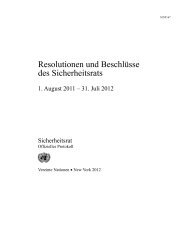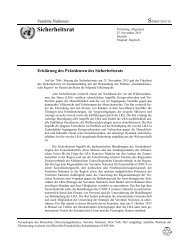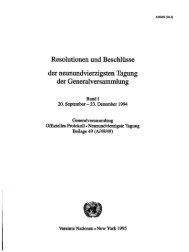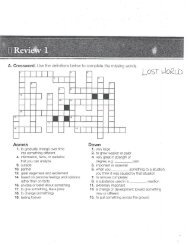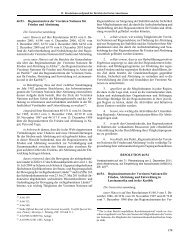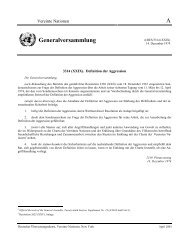IATG 01.80
IATG 01.80
IATG 01.80
You also want an ePaper? Increase the reach of your titles
YUMPU automatically turns print PDFs into web optimized ePapers that Google loves.
1/3<br />
Rx = (Kx . Mexp ) / ( 1 + (3175/Mexp) 2 ) 1/6<br />
12<br />
Rx = Range for Damage Level ‘x’ (m)<br />
Table 29: Damage Range to Buildings Estimation<br />
<strong>IATG</strong> <strong>01.80</strong>:2011[E]<br />
1st Edition (2011-10-01)<br />
Kx = Constant for Damage Level ‘x’ (See Table 29)<br />
Mexp = Mass of Explosive (kg)<br />
Values for Kx were initially derived by Jarrett and subsequently revised by Gilbert, Lees and<br />
Scilly. 27 The revised values take account of the casing factor, which is the degree of energy<br />
imparted to the primary fragments from the casing, thereby reducing the air blast energy available.<br />
Kx for Damage<br />
Category<br />
Jarrett Gilbert, Lees and Scilly<br />
A 3.8 4.8<br />
B 5.6 7.1<br />
CB 9.6 12.4<br />
CA 28.0 21.3<br />
D 56.0 42.6<br />
10.2 Fragmentation<br />
Table 30: ‘K’ Factors for Table 29<br />
The extent to which fragments will penetrate structures on impact is dependent on a range of<br />
variables, 28 hence leading to very complex expressions for each possible case. These expressions<br />
are empirically derived for specific building materials and fragment combinations. Therefore the<br />
prediction of fragment induced structural damage from hypothetical explosions cannot be easily<br />
predicted without access to a massive range of data. This data is often held by the military and<br />
hence classified.<br />
The example at Table 31 is for the penetration depth of flat-faced cylindrical fragments impacting<br />
on concrete. It may be used in an ECA as an example of damage that could be expected to<br />
modern building structures.<br />
For x/d < 2<br />
x = (2.74 . 10 -5 (((D . d 1/5 )/s 1/2 ) . V 1.8 . 4d 2 )) 1/2<br />
For x/d > 2<br />
x = 2.74 . 10 -5 (((D . d 1/5 )/s 1/2 ) . V 1.8 . d + d)<br />
10.3 Ground shock<br />
x = Fragment Penetration Depth (m)<br />
d = Fragment Diameter (m)<br />
D = Fragment Density (kg/m 3 )<br />
s = Compressive Strength of Concrete (Pa)<br />
V = Fragment Velocity (m/s)<br />
Table 31: Structural Penetration (Concrete v Flat Faced Cylinder)<br />
Ground shock can be understood as a vibration wave travelling through the ground. The wave<br />
takes the form of a sin wave and hence amplitude is a characteristic parameter.<br />
27 Gilbert S M, Lees F P and Scilly N F. A Model Hazard Assessment of the Explosion of an Explosives Vehicle in a Built-<br />
Up Area. Minutes of the 26 th US Department of Defense Explosives Safety Board Seminar. Miami. USA. 1994.<br />
28 For example: 1) building material strength, ductility and elasticity; 2) fragment velocity; 3) fragment shape on impact; 3)<br />
fragment mass; 4) fragment material strength, ductility and elasticity etc.



